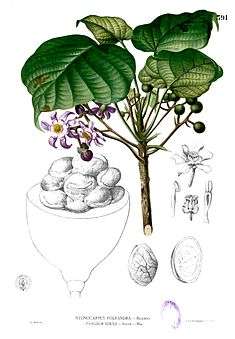Pangium edule
Pangium edule (Indonesian: keluak or keluwak; Malay: kepayang) is a tall tree native to the mangrove swamps of Southeast Asia (Indonesia, Malaysia and Papua New Guinea[2]). It produces a large poisonous fruit (the "football fruit") which can be made edible by fermentation.
The taxonomy of the tree is uncertain and it may also be classed in the Flacourtiaceae[2] or the Violales.
Ecology and cultivation
The tree requires many years to mature and the seeds are therefore most frequently harvested from wild trees, as it is not economically feasible to cultivate.[3] Although poisonous to humans, the seeds of the tree form part of the natural diet of the babirusa (Babyroussa babyrussa).[4]
Culinary uses
The fresh fruit and seeds contain hydrogen cyanide and are deadly poisonous if consumed without prior preparation.[5][6][7] The seeds are first boiled and then buried in ash, banana leaves and earth for forty days,[8] during which time, they turn from a creamy white colour to dark brown or black.[9] The method relies on the fact that the hydrogen cyanide released by the boiling and fermentation is water-soluble and easily washed out.
The kernels may be ground up to form a thick black gravy called rawon, popular dishes include nasi rawon, beef stew in keluwek paste,[10] and sambal rawon. A stew made with beef or chicken also exists in East Java.[11] The Toraja dish pammarrasan (black spice with fish or meat, also sometimes with vegetables) uses the black keluak powder. In Singapore and Malaysia, the seeds are best known as an essential ingredient in ayam (chicken) or babi (pork) buah keluak,[12][13] a mainstay of Peranakan cuisine.
Nutrition
The edible portions of the plant are an excellent source of vitamin C and high in iron.
Synonyms
- Indonesian:
- Malay:
- Kadazan:
- Pangi[14]
References
- ↑ "Sylloge Plantarum Novarum Itemque Minus Cognitarum a Praestantissimis Botanicis adhuc Viventibus Collecta et a Societate Regia Botanica Ratisbonensi Edita. Ratisbonae (Regensburg)". 2. 1825: 13.
- 1 2 Conn B, Damas K. "Pangium edule Reinw.". National Herbarium of New South Wales, and Papua New Guinea National Herbarium. Retrieved 15 Oct 2009.
- ↑ Andarwulan N, Fardiaz D, Wattimena GA, Shetty K (1999). "Antioxidant activity associated with lipid and phenolic mobilization during seed germination of Pangium edule Reinw.". Journal of Agricultural and Food Chemistry. 47 (8): 3158–3163. doi:10.1021/jf981287a.
- ↑ Leus K, Morgan CA, Dierenfeld ES (2001). "Nutrition". In Fischer M. Babirusa (Babyrousa babyrussa) Husbandry Manual. American Association of Zoos and Aquariums.
- ↑ Treub M (1896). "Sur la localisation, le transport, et le rôle de l'acide cyanhydrique dans le Pangium edule". Ann Jardin Bot Buitenzorg (in French). xiii: 1.
- ↑ Greshoff M (1906). Distribution of prussic acid in the vegetable kingdom. Report Brit Assn. York, England. p. 138.
- ↑ Willaman JJ (1917). "The estimation of hydrocyanic acid and the probable form in which it occurs in Sorghum vulgare". J Biol Chem. 29 (1): 25–36.
- ↑ Chia CC. "Buah Keluak". Retrieved 15 Oct 2009.
- ↑ Wong WH (11 Jan 2007). "Buah Keluak". National Parks. Retrieved 15 Oct 2009.
- ↑ Nyonya Rumah (24 July 2012). "Nasi Rawon Komplet" (in Indonesian). kompas.com. Retrieved 24 July 2013.
- ↑ "Tarry, Tarry Night". 22 May 2007. Retrieved 15 Oct 2009.
- ↑ Ng L (29 Oct 2007). "Ayam/Pork Buah Keluak". Retrieved 15 Oct 2009.
- ↑ Chia CC. "Ayam/Babi Buah Keluak". Retrieved 15 Oct 2009.
- 1 2 3 4 5 6 7 8 9 10 "Kluwak Pangium edule Reinw Familia: Flacourtiaceae Indonesia: Keluwek, keluwak, kluwak, kluwek, picung (Sunda), kepayang. Malaysia: Kepayang, Payang". DipoKusumo Farm Nursery. Retrieved 15 Oct 2009.
- ↑ "Kloewak [Pangium edule]". Objectief. Retrieved 15 Oct 2009.
